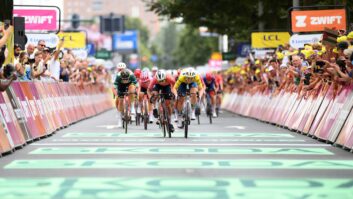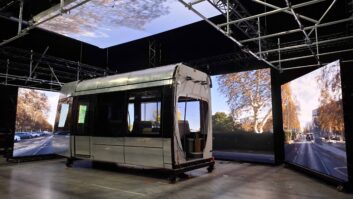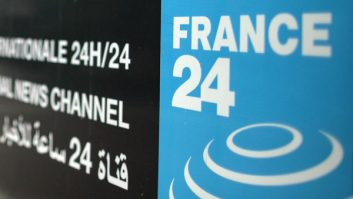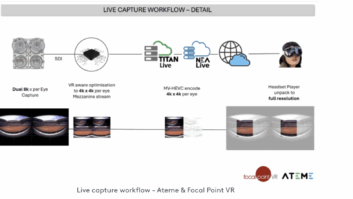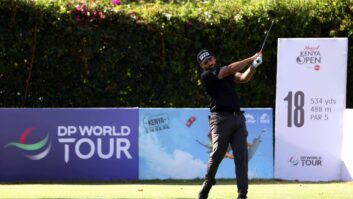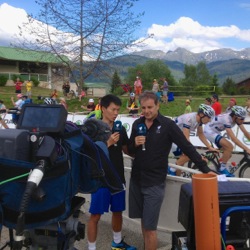
The Atomos field recorders have been popular (with more than 10,000 sold worldwide) as a low-cost way of adding higher quality recording to small cameras and DSLRs, but the company’s recent move into outside broadcast and studio recording, with its rack-mountable Ronin recorder, has opened up a whole new market.
One of the first Ronin users is Luxembourg-based FreeLens Television, which recently put two units to the test on the Tour de France, where they were part of a robust workflow that had to survive constant movement from stage to stage during the world’s biggest mobile sports event.
FreeLens provided all the production, post production facilities and technical crew for SBS Australia’s coverage of the Tour de France. It was working directly for the US/French production company Woods TV, which produces the Tour for NBC Sports and SBS. “But as they have a huge production for NBC Sports, they asked us to make the SBS part, which is a very small set up compared to the huge NBC production,” explains FreeLens’ production director, Yann Figuet.
This meant providing live inserts, ingest of the live international signal, ENG and post production. “The challenge of producing on the Tour de France is not only to find the proper technical solution, it’s also to find the perfect installation to set up, mount and de-rig every day during the 21 stages of the race. As SBS was also looking for some working spaces, we decided not to use an OB unit,” says Figuet. Instead, they installed the equipment in a trailer with two foldable sides to extend from around 12sqm to more than 40.
FreeLens crews have worked on the Tour for the last 15 years for different TV stations, but this was the first year it provided facilities to SBS Australia.
ProRes workflow
They decided to use Apple’s ProRes LT codec for all of the workflow from shooting to broadcasting, as the 100Mbps compression converts well to the 15Mbps HD signal sent over the satellite, but it requires relatively little bandwidth and storage for the quality it offers.
The ENG crews used Panasonic P2 cameras equipped with Atomos Samurai recorders, allowing them to record both on the P2 cards and Samurai, for extra security. “The pictures are immediately available to be copied into the server. Ingest time of a simple copy of ProRes LT file into the server is much quicker than the transfer of P2 material,” he explains.
The international clean feed is also recorded in ProRes LT in the central server, which is an Apple MacMini with 30TB of storage in a Thunderbolt-equipped Promise Pegasus R6 Raid storage. Ingest of the live feed is made using a Blackmagic Design UltraStudio 4K plugged in via Thunderbolt on the server.
“We use Softron Movie Recorder to ingest the live feed. Movie Recorder allows edit while ingest. The editing stations connected onto the gigabit network have immediate access to the pictures while the stage is on. An extra ingest station is available to record any other format coming from a third party connected to an XDCam and P2 VTR. All sources are routed through a 16×16 matrix.”
The two Ronins (a loan demo model and its own unit) were connected to the 16×16 router, and were able to record and playout any sources, such as playing out an interview that had been recorded on a Samurai. “We also use the Ronin as a spare recorder to have a ProRes LT record of the race in case the server goes down. It could also be a separate recording made from one of our fibre links. When the finish line is too far from the TC compound we install a fibre link to give our ENG crews the opportunity to playout an interview directly into the server, making footage available for the edit stations or live broadcasting,” he says.
During the races they had live stand up positions where SBS reporters could comment to camera. The cameras at these positions were linked to the production unit via fibre using a Camlinx system from VolAmp. Figuet says it is similar to a Telecast Copperhead system, but less expensive. “In the unit you have two-way HD-SDI, intercom, two-way analogue for IFB/return audio and analogue mic. It also includes a data channel for camera control with RMB or equivalent. Very good equipment.”
The return feed with English commentary was available for the live position on a 17-inch monitor. Some of the content was pre-recorded locally on the camera using the Samurai or in the production unit using the Ronin, which he says have been very reliable. “We are recording a minimum of five hours per day on SSD 500GB drives and we did not lose any frame so far.”
Prior to using the Atomos equipment, its previous set up on the Tour de France was much smaller, using XDCam HD VTRs and cameras and ingesting the content into stand-alone Final Cut Pro edit suites.
Its workflow now is a great deal more efficient. “Working with the server and gigabit network is a huge gain of time. ProRes LT quality is good enough and the files are not too big. It’s a perfect way to cover an event like the Tour de France where the facilities have to be as rugged as possible.
“As the files are available simultaneously on all the edit stations it is also a gain of productivity. Editors can make stories using the same rushes. We have done extensive tests before the Tour, and the results achieve our expectations. We are able to play, record and replay several flows at the same time without any crash or slowing down.”
One of the main attractions of the Atomos recorders is their low cost, and FreeLens bought them “because it’s for us the best solution for the price. Our requirement was to find equipment able to record directly in ProRes LT. Other brands propose LT codec, but Atomos was the best solution for several reasons: The touchscreen of both the Samurai and the Ronin includes all the needed details. It’s a real advantage to see the input picture versus other equipment without screens. Samurai and Ronin have exactly the same interface, a real advantage to work on both machines without noticing it,” he says.
Redundant power
However, “the big plus of the Ronin is the redundancy of the power supply. You can plug to a standard 220v and plug an extra 12v input via a battery adapter or using a 7.2v Sony mode battery. The no break power supply is a necessity when you use a machine to record the feed of such a major event. Even a standard XDCam, P2 or HDCam VTR is not equipped with a redundant power supply. For the Tour de France we even go further in using a UPS on the 220v network.”
They did consider buying a Blackmagic HyperDeck, but as it doesn’t support ProRes LT it wasn’t suitable. AJA’s KiPro does support the LT codec, but it is more expensive.
Atomos shipped its latest field recorder, the €995 Samurai Blade, just as the Tour entered its last week, so although FreeLens has ordered two, they didn’t arrive in time. The Blade has a much improved 1280×720 325dpi 5-inch SuperAtom IPS touchscreen that offers users gamma, brightness and contrast control, as well as vectorscope and RGB/luma parade features and runs the latest version of AtomOS, version 5 (which is only available for the Blade).
Like its Ninja-2 and Samurai predecessors, Samurai Blade records 10-bit 4:2:2 images using either ProRes or Avid DNxHD editing codecs. It uses commodity 2.5-inch computer HDD or SSD drives. The Samurai Blade includes tri-level focus peaking, zebra, false colour and blue-only monitoring in addition to waveform, and has standard BNC connectors.
“We extensively used the Samurai in the past and found the screen not good enough for viewfinder use. We expect the Blade to be better, avoiding the need to plug in an extra monitor. Ronin is a great machine, we will keep them and use them extensively as deck recorders,” says Figuet.
Three Samurai systems were used during the Tour, one on each of two ENG cameras, the other shared between the two fibre-linked cameras for any pre-recorded items. There were three cameramen (one from FreeLens and two from SBS), with each cameraman also doing some editing.
There were three edit suites in the trailer with MacPro 12 core systems, but the cameramen also edited on the network using MacBook Pro laptops, so it could have up to five Final Cut Pro 7 systems plugged into the network at any time. It used FCP7 “as the crews are used to it and don’t feel comfortable with X,” he says. “We took the decision with SBS to go with FCP7 as everybody was much more comfortable with it and FCP 7 brings all the facilities for the kind of work we do here on the Tour.”
By David Fox
